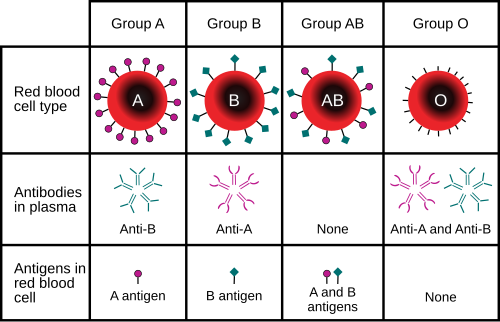Blood type
Blood type or blood group is a classification of blood based on the presence or absence of inherited antigenic substances on the surface of red blood cells (RBCs).
Blood types predict whether a serious reaction will occur in a blood transfusion. This reaction is called a "haemolytic reaction". It may destroy red blood cells, and cause renal failure. Shock is likely to occur, and death is a possibility.
When a blood transfusion or an organ transplant takes place, it is vital to know the blood types of the donor (who gives blood) and the receiver (who needs blood).
There are a number of human blood group systems. Of these systems, the ABO blood group system and the Rhesus blood group system are the most important. In this system the presence or absence of the A-antigen, the B-antigen and the RhD-antigen are determined.
ABO system
The principle
The principle of the ABO system is that antigens – in this instance, sugars exposed on the surface of red blood cells – differ between individuals. This was first discovered by Karl Landsteiner. People have immunological tolerance only for what occurs in their own bodies. As a result, humans may produce antibodies against natural components in the bodies of other people, but not themselves. So, people may produce antibodies against A and/or B antigens if they are not in their blood.
These antibodies clump red blood cells together if they carry the foreign antigens. This response can cause death when large amounts of such cells are encountered after a blood transfusion. Because A and B antigens are chemically modified from a precursor form that is also present in type O individuals, people with type A and B antigens can accept blood from type O individuals.
Anti-A and anti-B antibodies are not present in the newborn. They appear in the first years of life. Anti-A and anti-B antibodies are usually too big to pass through the placenta to the foetal blood circulation.
The test
In a laboratory, blood is tested for antigens. When a certain antigen is found, antibodies are also always found. Antibodies attack (attach to) antigens that they do not recognize.
- Group A (with the A-antigen) has anti-B antibodies
- Group B (with the B-antigen) has anti-A antibodies
- Group AB (with both A and B-antigens) has no antibodies
- Group O (with no antigens) has anti-A and anti-B antibodies
The blood is thus tagged as being A positive, O negative for instance, where the letter refers to the ABO blood group and "positive" or "negative" refers to whether or not the RhD-antigen of the Rhesus blood group system was found. It can also be written A+ and O-, respectively.
Compatibility
- Group O have no antigens, but have anti-A and anti-B antibodies. This means that they can only receive blood from other people in group O, but they can give to any ABO group.
- Group A have anti-B antibodies, so they can only receive blood from people within group A or O. These two groups do not have the B-antigen. They can donate blood to people from group A or AB.
- Group B have anti-A antibodies, so they can only receive blood from people within group B or O. They can donate to groups B or AB.
- Blood group AB have no antibodies, so they can receive blood from any blood group. However, they can only donate blood to other people with blood group AB.
People with type O negative blood are often called universal donors because they can give blood to any other blood group. People with type AB positive blood are called universal recipients because they can receive blood from any other blood group.
Rhesus factor
The Rh factor (Rh meaning Rhesus) is a feature of the second most common blood-group system in human-blood transfusion. it is named after the Rhesus monkey where they were first discovered.[1] Rh is an inherited trait,[2] which refers to a protein on the surface of an individual's red blood cells.
The Rh factor is separate from, and in addition to, ABO groups. The Rh factor is either present on individual's red blood cells or it is not.[1] Rh positive means the factor is present. Rh negative means it is not present. In blood transfusions it is important that the blood donor and recipient have the same Rh factor and same blood group.[3]
Before a transfusion takes place blood is thoroughly tested for anything that might cause problems for the receiver.
Blood Type Media
Simplified Punnett square of the possible genotypes and phenotypes of children given genotypes and phenotypes of their mother (rows) and father (columns) shaded by phenotype
References
- ↑ 1.0 1.1 John Campbell, Campbell's Physiology Notes For Nurses (London; Philadelphia: Whurr Publishers, 2003), p. 123
- ↑ "Rh factor blood test". Mayo Foundation for Medical Education and Research. 16 January 2012. Retrieved 15 December 2014.
- ↑ Vidya Ratan, Handbook of human physiology (New Delhi: Jaypee Bros. Medical Publishers, 1993), p. 57







